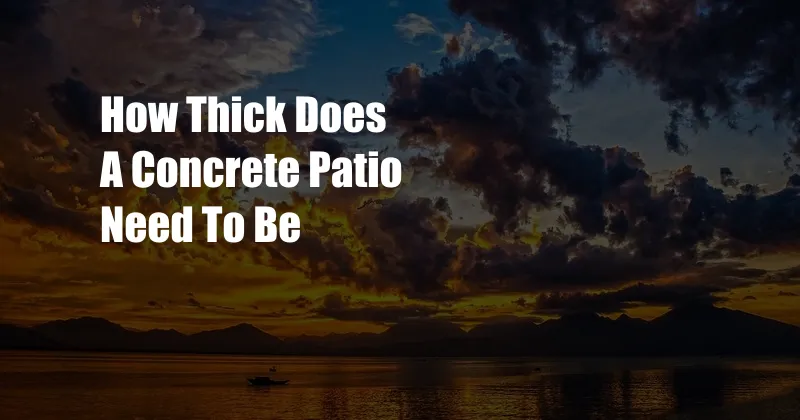
How Thick Does a Concrete Patio Need to Be?
As I was planning to build a concrete patio in my backyard, a question popped into my mind: how thick should it be? I didn’t want it to be too thin and crack easily, but I also didn’t want to use more concrete than necessary. After some research and consultations with experts, I’ve gathered all the necessary information to answer this question.
In this comprehensive guide, we’ll dive into the factors influencing the thickness of a concrete patio, explore the recommended measurements, and provide expert tips to ensure durability and longevity. Get ready to transform your backyard into a beautiful and functional outdoor space.
Concrete Patio Thickness: A Balancing Act
Factors to Consider:
1. Purpose and Usage: The intended use of your patio plays a crucial role. A patio designed for occasional foot traffic can be thinner than one meant for heavy use, such as parking vehicles or hosting large gatherings.
2. Subgrade Stability: The stability of the soil beneath your patio is equally important. Well-compacted soil will provide a solid foundation, allowing for a thinner patio. Unstable soil may require a thicker slab to prevent cracking.
3. Climate Conditions: The climate in your area can impact the thickness of your patio. Extreme temperature fluctuations, freeze-thaw cycles, or expansive soils may necessitate a thicker patio slab to withstand these conditions.
Recommended Thickness: The Ideal Balance
Based on these factors, the recommended thickness for a concrete patio generally ranges between 4 and 6 inches.
- 4 inches: Suitable for patios with light foot traffic, such as those used for occasional seating or grilling.
- 5 inches: Ideal for patios that will experience moderate use, including regular foot traffic and occasional furniture placement.
- 6 inches: Recommended for heavily used patios, parking areas, or patios in areas with extreme weather conditions.
Expert Tips for a Durable Concrete Patio
1. Reinforcement: Adding steel reinforcement, such as rebar or wire mesh, to your concrete mix will significantly increase its strength and prevent cracking.
2. Proper Curing: Allow the concrete to cure slowly and evenly by keeping it moist for at least a week. This process helps the concrete gain strength and reduce the risk of shrinkage cracks.
FAQs: Common Questions Answered
1. Can I DIY a concrete patio?
Yes, DIY concrete patios are possible with proper planning and preparation. However, for larger or complex patios, it’s recommended to hire a professional contractor.
2. What type of concrete should I use?
Concrete mixes specifically designed for patios are available at most hardware stores. These mixes typically have the appropriate strength and workability for outdoor applications.
3. How long will my concrete patio last?
With proper construction and maintenance, a concrete patio can last for several decades or even longer. Regular sealing and repairs are crucial for extending its lifespan.
Conclusion
The thickness of a concrete patio is a crucial factor that influences its durability and longevity. By considering the intended use, subgrade stability, climate conditions, and recommended measurements, you can determine the optimal thickness for your patio. Remember to incorporate expert tips and follow proper construction and maintenance practices to ensure a beautiful and long-lasting outdoor space.